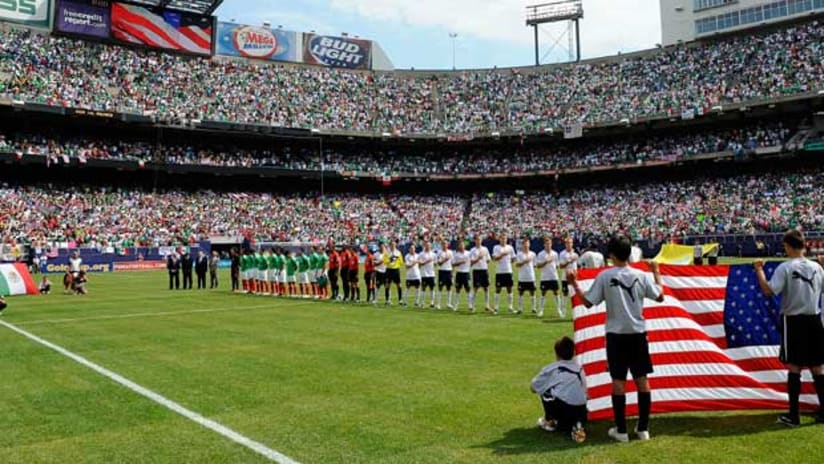It’s good being a fan. Fans get to bask in the glow of a fantastic year of soccer. Fans get to relive their favorite moments over and again at the pubs and in the stands. Fans get to fantasize about the excitement and glory the next World Cup will bring.
Players and managers, however, get back to work. And the manager of the US national team—whether it’s Bob Bradley or not—has to have one goal in mind at this point: The 2011 Gold Cup.
Long regarded as the bastard child of continental competitions even among hardcore fans, the Gold Cup is now looked upon as a major building block for a successful cycle. And it’s not just because there’s a double handful of regional pride at stake any time the US and Mexico square off in a meaningful competition. The Gold Cup—well, every other Gold Cup, anyway—punches a nation’s ticket to the Confederations Cup. As the world learned in 2009, nobody wants to miss that.
Whoever is steering the ship for the US will have a lot of the work already done for him, since the core of the squad is in or near their prime. However, there are a few gaps to fill, and a few guys in MLS who look capable of getting the job done.
So for the time being, forget 2014. Instead, think about 2011.
[inlinenode:315464]Omar Gonzalez, LA Galaxy: Gonzalez, LA’s mountain of a central defender, is probably the most national-team ready player in MLS. He proved as much earlier this week by holding his own against Brazil in his first senior cap.
Gonzalez’s physical tools are readily apparent, but it’s his mental tools that allowed him to make the transition so smoothly. He reads the game like a veteran. He doesn’t hurry plays. If he is beaten, he learns from it and improves as the game wears on. That level of maturity and accountability is something managers look for in defenders.
Gonzalez has a few veterans in front of him in the US player pool, but don’t be surprised if, by the time the Gold Cup comes around, he’s passed them all on the depth chart.
[inlinenode:306909]Sean Franklin, LA Galaxy: Franklin won MLS Rookie of the Year in 2008 as a central defender, but moved to right back in 2009. In 2010 he’s made the position his own.
His most obvious gift is his speed. He gets up and down the touchline as well as anyone in the league, but to call him a product of his athleticism would do him an injustice. He’s turned into a very clever off-the-ball threat, dragging defenders away from Landon Donovan and opening spaces for the Galaxy to attack.
When Franklin gets the ball he’s not likely to beat anyone 1v1, but he’s an able crosser and a good passer. Just as important, he’s a fantastic 1v1 defender. That’s a real plus for him, since the other right backs in the US pool—Steve Cherundolo and Jonathan Spector—are average at best.
If he wins a starting job with the US by next summer, the ability to defend well in isolation will be a big reason why.
[inlinenode:304828]Tim Ream, NY Red Bulls: Ream was the 2010 SuperDraft’s first “Who’s that guy?” pick. His entire pre-MLS career seemed to happen well under the radar in spite of a very solid career at one of the country’s great soccer schools, the University of St. Louis.
He’s on the radar now.
Ream, a starter in central defense for the Red Bulls since opening day, is the best distributor from the back the league has had in years, and he’s smooth on the ball like no other defender in the league. Fans compare him to Thomas Dooley and Lubos Kubik. His manager, Hans Backe, compared him to Rio Ferdinand.
[inlinenode:314565]Brek Shea, FC Dallas: Admit it, you like watching this guy play. Sure, he has an arrogance and a swagger that can be annoying (if you’re not a Dallas fan, anyway). And the mullet he was rocking earlier this season could cause nightmares for even the most stout-hearted.
But you want an attacker to play with a bit of arrogance and individualism. Shea, like fellow Texan Clint Dempsey, plays with a chip on his shoulder and radiates an “I know how good I am” confidence that the US team sometimes lacks.
After bouncing around several different positions over the past couple of seasons, Shea has finally found a home on the left side of the midfield in Schellas Hyndman’s 4-1-4-1. Given how comfortable he looks and how well Dallas are playing, he’s not likely to give up the spot any time soon.
It’ll be a tough job winning that position with the US since he’ll be behind stallwarts Dempsey and Benny Feilhaber, but don’t rule Shea out. His innate physical gifts, a blossoming soccer mind and a cannon of a left foot means he’ll get plenty of looks in a US shirt.
[inline_node:315722]Danny Mwanga, Philadelphia Union: Mwanga could actually help the US team right now, if only he was eligible. The 19-year-old forward is a native of the Congo and is still in the process of acquiring US citizenship. Reports indicate that he’ll likely complete the process by next May, and he’s on record saying he’d like to represent the US.
If he gets that chance, he’ll bring the single biggest thing the US needs right now: finishing. Mwanga has six goals this year on just 17 shots. For the sake of comparison, Juan Pablo Angel has 11 goals on 70 shots. Edson Buddle has 12 on 67.
That’s just what the doctor ordered for this US team, which has had little problem generating chances but all kinds of problems finishing them. If Mwanga earns his citizenship in time for the Gold Cup, don’t be at all surprised if the manager—whoever he is—throws caution to the wind and brings him in straight away.


